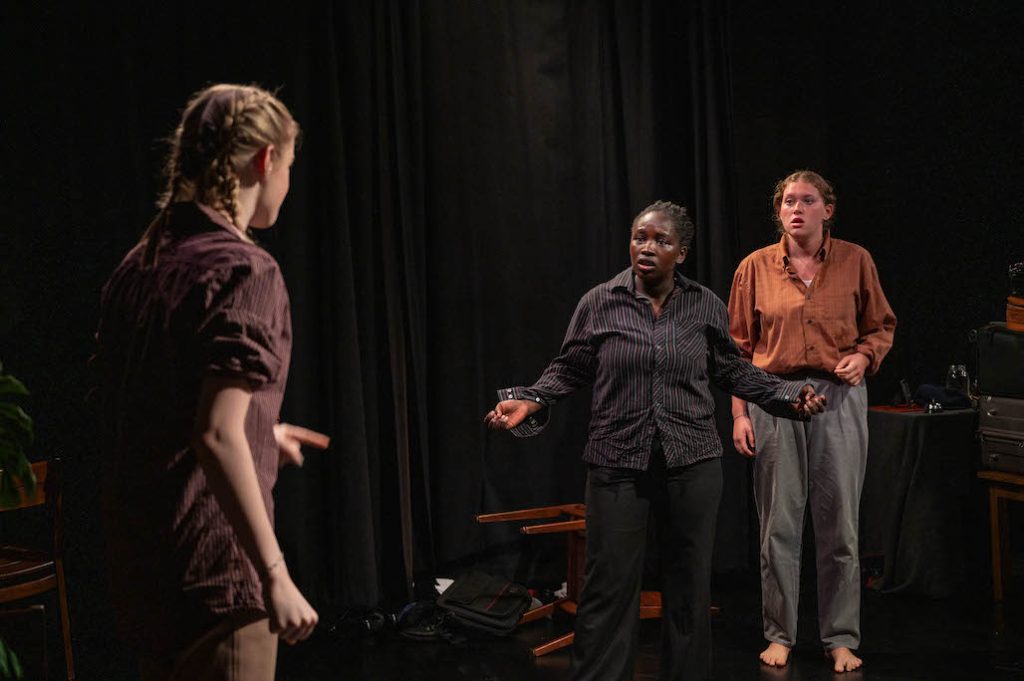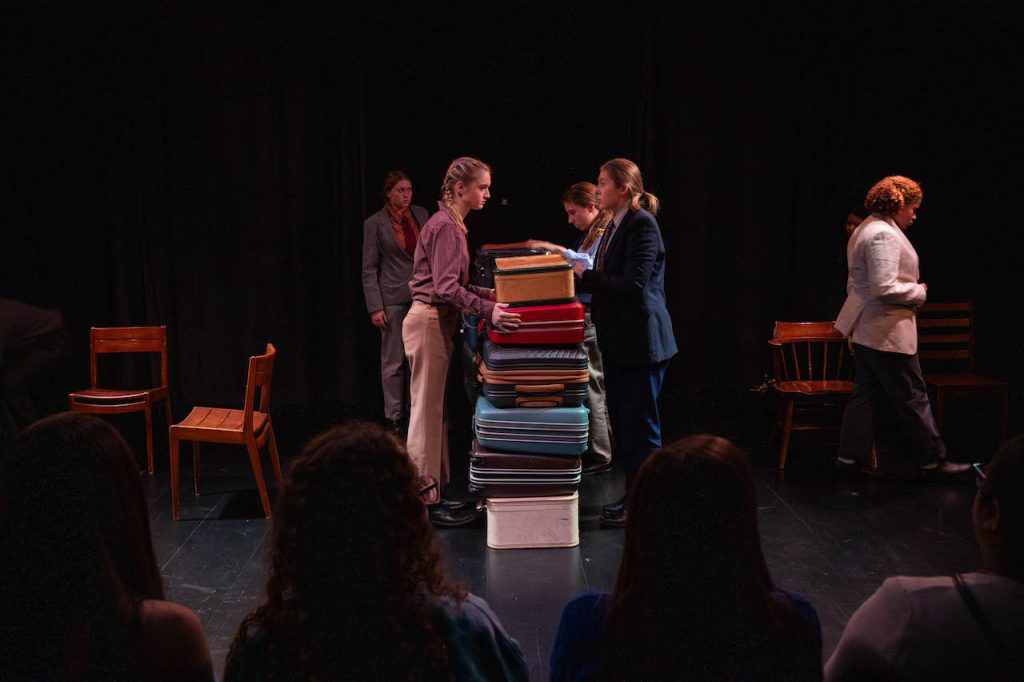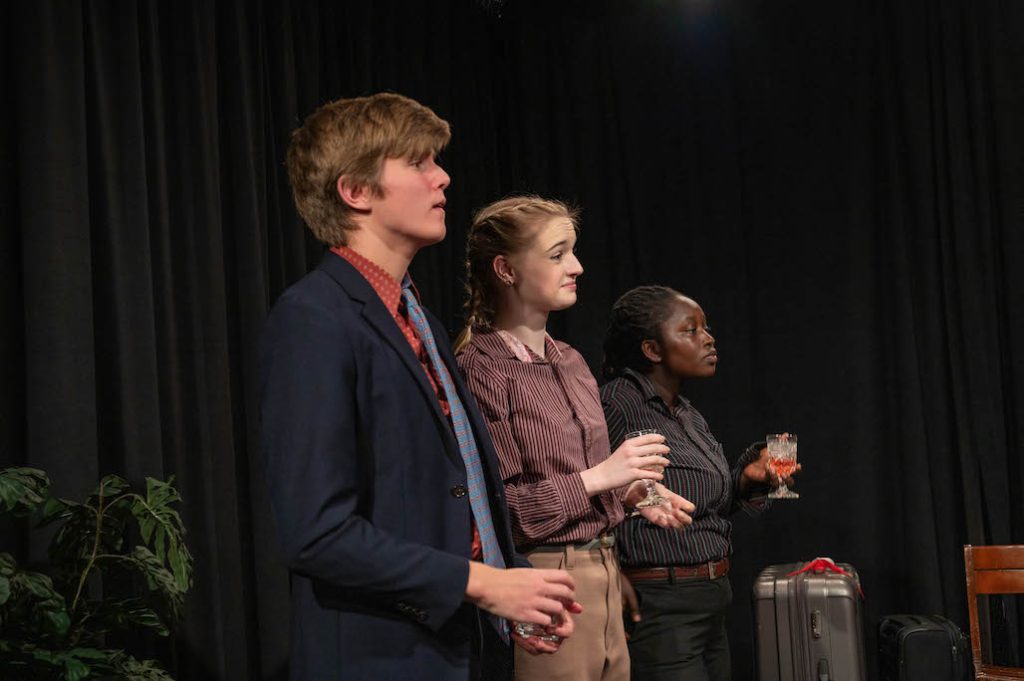BY FINN KROL ’27
On October 7th and 8th, walking into Studio A in the Janet Kinghorn Bernhard theater meant walking into a classy hotel lobby. Warm brown furniture scattered about the space, a concierge table in the back, big leafy potted plants by the doors. Soft piano music played in the background as you walked in and were greeted by a well-dressed concierge. Said well-dressed concierge, played by Becca Durst ’27, frantically cleaned miscellaneous items from the floor, including but not limited to two decks of cards— one red, one blue, cleaning supplies, rope, a broken clock, a concierge’s bell, a framed photo, and a bottle of alcohol. A messy sight, further added to by Durst’s frantic interactions with the audience. One can’t help but think that this concierge is falling apart at the seams. This is how Us and Them by David Campton begins.

Directed by Katya Yurkovskaya ’26, Us and Them is about two groups of people who ultimately decide to live on the same plot of land. The show is a commentary on sharing— can they do it? Will they do it successfully? The Recorder, i.e the well-dressed concierge, left the question answered with non-answers about human nature. She scribbled away in her notebook as two groups filed into the hotel carrying many suitcases.
On house left, the group costumed in warm, red tones, entered. On house right, the group in cool, dusky blue tones did the same. Weary and weathered, Group A, or the red group, was said to come from the East, featuring Spokesman A (Jade Kleinberg ’28), A1 (Maggie Krieg ’26), A2 (Beti Essa ’28), and A3 (Tommy Catalani ’28). Group B, the blue group coming from the West, featured Spokesperson B (Asher Cortés ’27), B1 (Lila Sandler ’27), B2 (Alanna Herbert ’29), and B3 (Keziah Bayson ‘29)
The travelers placed their luggage down and rested for a moment. They decided that this was a good place to stay, to settle. Their lines overlapped and intersected, often with members of both groups saying the same thing just a short heartbeat after the other. The concierge watched and waited, sometimes disappearing from view entirely, other times, offering the red group and only the red group drinks.
Quickly, tensions rose. In a cleverly directed standoff between Group A and Group B, Kleinberg and Cortés went head-to head as the spokespeople for their respective groups. Campton gives the actors very sparse lines to work with, but regardless, it soon became clear that a line had to be drawn differentiating the two properties. Business was to be conducted. The Recorder looked on watchfully, almost as if waiting for something. The groups obtained a rope from the Recorder and argued over how and where in the lobby to place the rope. Krieg shared that chickens can’t read warning signs to stay on one side of a fence- that the chickens could jump over the string. Essa added that sheep can’t read warning signs, either. Krieg pointed out the lack of a “true” divider between the two groups and their belongings. Together, the groups decided to build a wall high enough to keep all livestock to their respective sides. At least, that’s all they claimed it would do. “Good neighbors make good walls.” “Good walls make good neighbors.” Everyone was in agreement

Then, the music shifted, so did the lights. The stage became darker, the music moodier. The groups built the wall using their suitcases. They made eye contact with each other as they moved furniture in Hamilton-esque fashion- slowly and with purpose, above their heads or below their chests, in tune with the music. Yurkovskaya’s directing and sound design shines through here as the show begins its’ slow departure from realism.
The groups settled, but not before long they begin to wonder about what the other group is doing and speaking of. Sandler instigates unease and distrust amidst the blue group, claiming that the red group is wicked. Bayson disagrees, but doubt overrides their disagreement. The same happens on the other side. Cattalani disagrees with Krieg, but is overridden as well. Through mirrored blocking, Yurkovskaya helps tell the story of mob mentality and humanity that characterizes Us and Them.
The groups made the choice to look over the wall. Each group stood up on chairs in a line to peer over the edge. They end up scaring each other in a highly humorous moment, screaming briefly and hopping off the chairs. The audience laughed, but we were met with both groups’s slow spiral into a doomed fate immediately after. They decided to tear the wall down, to fight each other instead. Everyone was braced to fight, when suddenly everything stopped.
In a truly bone-chilling moment, the Recorder had walked to the front of the stage, and with one sharp, short motion of their hands, made everyone fall limp, bent over at the waist. Liz Gluz’s lightning design spotlit every group member as nothing but a mere puppet, doomed to play out a violent, destructive and deeply human end.

The Recorder snapped her fingers, and they started to fight. Each group member fought in sequences with opposing group members. The fight was stylistic in direction, with each actor fighting in slow-motion over a long distance with their sparring partners. Group members started to go down, one by one. Finally, Cattalani and Sandler were the only two left standing. From opposing groups, Cattalani held Sandler as she slumped to the floor. With her dying breath, she blames the wall for the destruction. It was too late to save her— and it was too late for any of them to realize that the wall wasn’t the problem at all. Before Cattalani had a minute to process, the Recorder snapped her fingers. Cattalani and Bayson were at her beck and call. She sent them to collect all the watches, jewelry and money from the fallen group members, which they dumped dutifully into a basket at her feet.
With the wall gone and the groups dead, we saw who was truly in control— the anxious concierge was no more. All that remained was the power to tell the story and to record the action. At least, that’s Campton’s final message, delivered via the Recorder’s lines as she sweeps the stage, dancing in between dead bodies on the floor.

Us and Them ran October 7th -8th in Studio A. Lightning design was done by Liz Gluz. Scenic and props design was done by Penelope Gibeau and Jojo Zou. The show was costumed by Lily Lugiano, stage managed by Noelle Dravis, and assistant stage managed by Sarah Drowne.
Photos by Logan Waugh ’26
***
Finn Krol ’27 is a Staff Writer for the Skidmore Theater Living Newsletter
